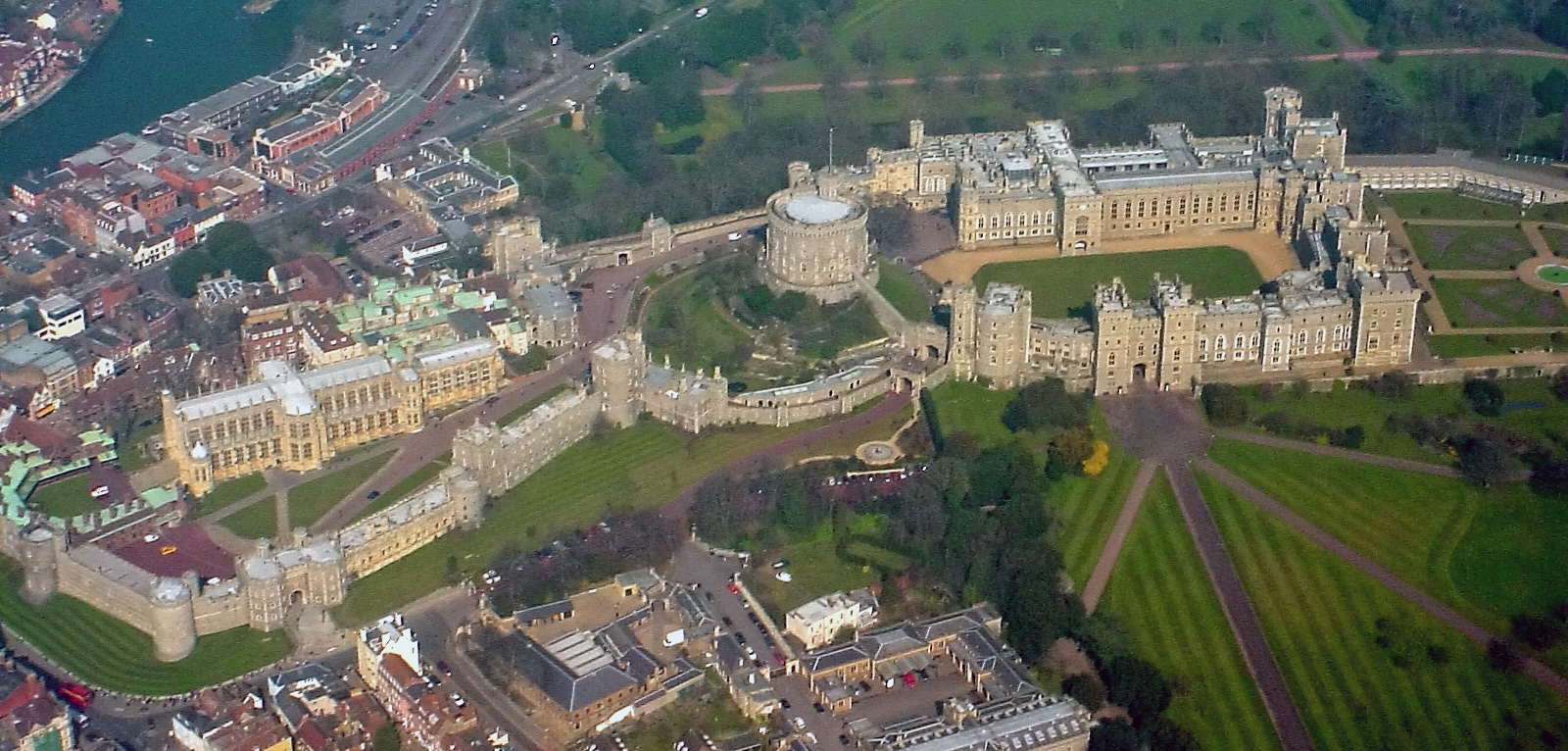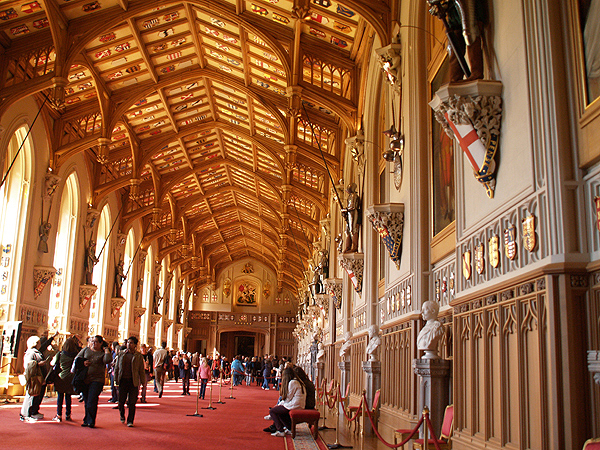by Scott Mehl
© Unofficial Royalty 2012

Windsor Castle from the air. source: Wikipedia, photo by Mark S. Jobling
Windsor Castle
Windsor Castle is one of the official residences of The Sovereign, and where the late Queen Elizabeth II spent most weekends and several weeks each year. The castle is also used often as the site of State and official visits, and each year hosts the service for the Order of the Garter. With its imposing silhouette, Windsor Castle has become a symbol of the British monarchy.
Following the Norman invasion in 1066, William the Conqueror built a fortress on the site, which has been enlarged and expanded greatly by successive sovereigns. The original Round Tower was built and large walls surrounded the entire complex. A century later, King Henry II rebuilt much of the fortress in stone, including the Round Tower, outer walls, and many other structures. These included the Upper Ward, which contained the Royal Apartments. Successive sovereigns made their own changes and expansions to Windsor Castle – Edward III added the St. George’s Hall for the newly created Order of the Garter, and Edward IV began the construction of St. George’s Chapel in the Lower Ward.

Windsor Castle in 1658. source: Wikipedia
It was King Charles II who, following the Restoration, set out to turn the Castle into a showplace, hiring the best craftsmen and artists to build and decorate new State Apartments in the northern wing of the Upper Ward. Most of these rooms still exist and are included in the public tours of the castle.
During the reign of King George III, he made further changes, installing his wife and large family in the east and south wings, while the King himself lived in a small suite of rooms in the northern wing. Due to his illness, he wanted to be sure that his wife and family were insulated from his bursts of madness. His successor, King George IV, also made significant changes to the castle – often credited with turning the mere ‘castle’ into a true ‘palace’. During his reign, the Waterloo Chamber was added to recognize Napoleon’s defeat at the Battle of Waterloo.
Queen Victoria and her family used Windsor Castle quite often, and in 1861, it was where her beloved Prince Albert died of typhoid. The Queen turned his rooms into a virtual shrine to her late husband, insisting that they remain as they were the day he died. Following Albert’s death, the Queen spent even more time at Windsor, only using Buckingham Palace in London when absolutely necessary. Later generations have used Windsor quite regularly. During World War II, it is where the late Queen Elizabeth II and her sister, Princess Margaret, lived, along with other members of the extended royal family.
In 1992, on Queen Elizabeth II and Duke of Edinburgh’s 45th wedding anniversary, a massive fire broke out at the castle. During some restoration work in the Private Chapel, a curtain came into contact with a spotlight and sparked a fire that damaged or destroyed over 100 rooms and took over 15 hours to contain. The subsequent restoration took nearly 5 years and cost £37million (the majority of which was met by opening the State Rooms at Buckingham Palace to the public). You can read more about the fire at Windsor Castle here.
Despite its grand State Rooms and imposing stone walls, Windsor Castle was very much a home to the late Queen Elizabeth II and the late Duke of Edinburgh. As well as staying at Windsor on most weekends, Queen Elizabeth II officially took up residence at the castle for a month in March or April, over Easter. She also spent a week in June, which coincides with Royal Ascot and the service for the Order of the Garter.
The Castle can be broken down into three sections – The Lower Ward, The Middle Ward, and The Upper Ward.
The Lower Ward contains St. George’s Chapel, The Albert Memorial Chapel (originally The Lady Chapel) and the Horseshoe Cloister. It also contains lodgings for the Military Knights of Windsor and the residence of the Governor of the Military Knights.
The Middle Ward consists primarily of The Round Tower, which stands in the center between the Lower and Upper Wards. The Round Tower was part of the original fortress and was rebuilt by King Henry II in 1170. Today, it houses the Royal Archives.

Queen Elizabeth II reviewing troops during the Diamond Jubilee Parade and Muster, May 2012, in the quadrangle of the Upper Ward. To the left is the Guest Entrance, and to the right is The Queen’s Entrance. source: Wikipedia, Defence Imagery under the Open Government License v1.0
The Upper Ward is the primary section of the castle and contains the State Apartments as well as the private apartments of the Royal Family. Built around a large quadrangle, the Upper Ward has over 950 rooms, and about 225 of those are bedrooms!
The State Apartments are located in the northern wing. These include the apartments of King Charles II and Queen Catherine (Catherine of Braganza). Also within the State Apartments are:

St.George’s Hall; Credit – Wikipedia
St. George’s Hall runs along the northern wing of the Upper Ward, overlooking the quadrangle. The majestic hall is the site of State dinners.

The Waterloo Chamber. source: The Daily Mail
The Waterloo Chamber was created in the 1820s and displays portraits that commemorate Napoleon’s defeat at the Battle of Waterloo in 1815. Today, it is often used for receptions and luncheons, including the luncheon for Knights and Ladies of the Garter prior to the Garter service at St. George’s Chapel each June.
The Semi-State Apartments, located in the eastern wing, are also considered part of the Private Apartments. Some of the prominent rooms include:
Located in the eastern wing of the Upper Ward, the Crimson Drawing Room is the principal room in the private apartments and is often used for private meetings and official functions. This is one of the rooms which was destroyed by the fire in 1992.
The Green Drawing Room, at one time the library, is next to the Crimson Drawing Room in the eastern wing and is also used for formal entertaining. During State visits, it often features a display of items from The Royal Collection pertaining to the country of the visiting Head of State. It is also used occasionally for meetings of the Privy Council.
The White Drawing Room, in the eastern wing, is typically used for official visits. It is often where The Sovereign meets with ministers and foreign guests. It was also the site of the formal photos taken after the wedding of The Prince of Wales and Duchess of Cornwall in 2005.
The State Dining Room, located in the northeastern corner of the Upper Ward, is used for smaller functions and meetings.
The Garter Throne Room is used primarily during the investiture of new Knights and Ladies of the Garter. It is located in the northern wing, overlooking the North Terrace.

The eastern wing overlooking the East Terrace. source: Wikipedia, photo by David Stanley
The actual private apartments of The Sovereign are in the eastern wing, overlooking the East Terrace and Gardens. These are accessed through the Queen’s Entrance, located in the south-eastern corner of the quadrangle.

Frogmore House in the Home Park. source: Wikipedia, photo by Gill Hicks
Outside the castle walls is the Home Park. Located primarily to the east of the castle, the Home Park is the private park of the castle and covers about 655 acres. Within the Home Park are The Frogmore Estate, two farms, the Windsor Farm Shop, and the Windsor Home Park Lawn Tennis Club. The Home Park is also the site of the Royal Windsor Horse Show each year.

The Copper Horse, Windsor Great Park. source: The Crown Estate
Extending further to the south is Windsor Great Park. Covering over 5,000 acres, and managed by the Crown Estate, Windsor Great Park includes the majestic Long Walk, which extends from the southern wing of the palace and proceeds 2.65 miles to The Copper Horse, a statue of King George III on horseback. Also within Windsor Great Park are several other royal residences including Royal Lodge, Cumberland Lodge, and Fort Belvedere.
Learn more about the other British Royal Residences here!
This article is the intellectual property of Unofficial Royalty and is NOT TO BE COPIED, EDITED, OR POSTED IN ANY FORM ON ANOTHER WEBSITE under any circumstances. It is permissible to use a link that directs to Unofficial Royalty.


